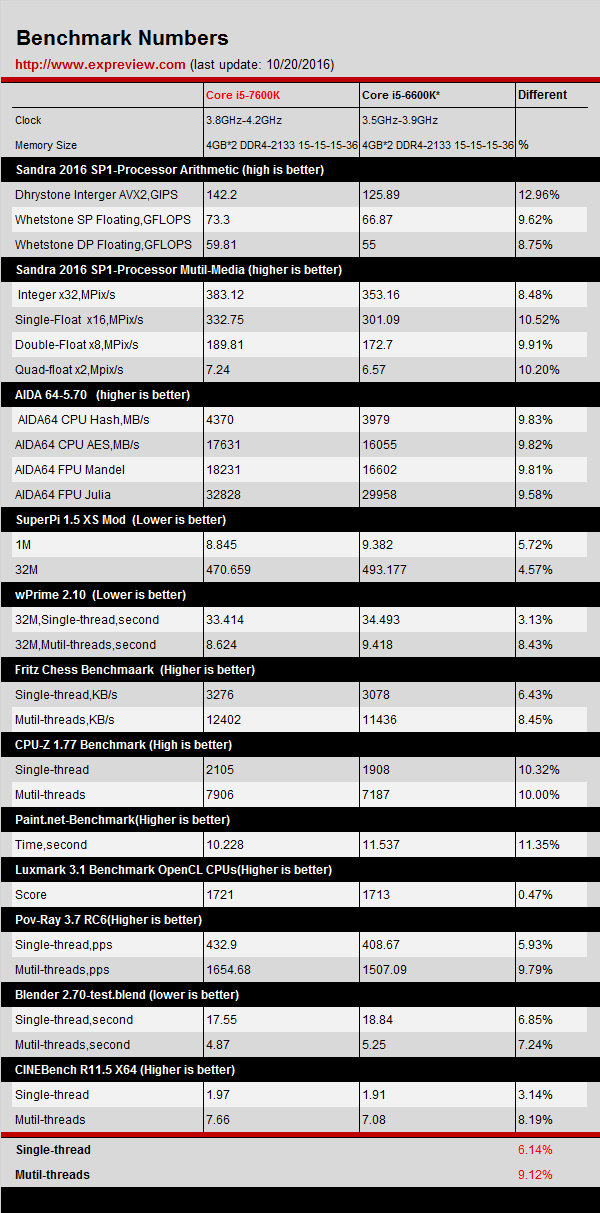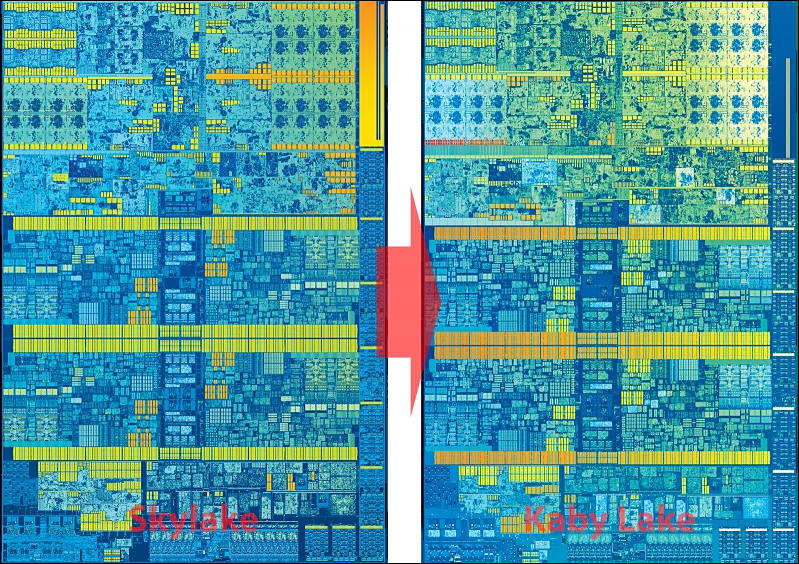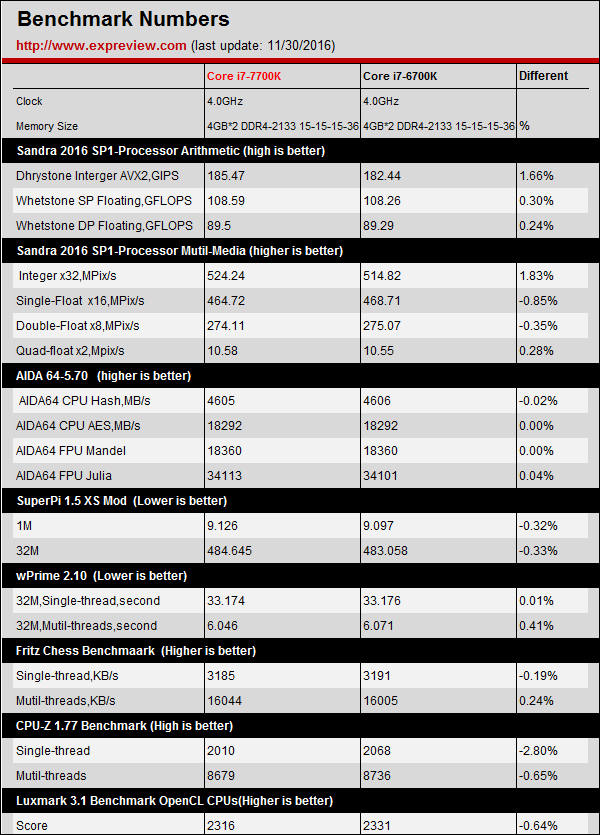
It allows to keep PV going, with more focus towards AI, but keeping be one of the few truly independent places.
-
Official launch will be on 5th January at CES 2017
- Core i7-7700K, 4/8, 4.2 GHz, 8MB Cache, 91W TP, $349 US
- Core i7-7700, 4/8, 3.6 GHz, 8 MB Cache, 65W TP, $309 US
- Core i5-7600K, 4/4, 3.8 GHz, 6 MB Cache, 91W TP, $239 US
- Core i5-7600, 4/4, 3.5 GHz, 6 MB Cache, 65W TP, $219 US
http://wccftech.com/intel-kaby-lake-core-i7-7700k-price-leak/
So, all prices stay same as they are for current gen.
-
Not so bad. And Z170/H170 motherboards are getting firmware updates.
-

Taking to account frequency real difference must be around 2-3%.

 vs6600k.png600 x 1213 - 52K
vs6600k.png600 x 1213 - 52K -
Core i5-7600K test. Small correction from previous post.
If you exclude frequency from equation, difference with Skylake is within 1%.Next CPU, according to Intel, also will have exact same performance on same frequency.
-
Intel its reaching some problems with minaturization and implementation of this.new.arquitectures. what i find amazing is likely we will not see in looong time any huge improvement untill 3d staked chips. Even.then heat will be more of an issue. Than a performance.solution
-
what i find amazing is likely we will not see in looong time any huge improvement untill 3d staked chips.
You can't make stacked GPU or processors, not until some internal liquid cooling or such.
Just thermal output become too big.
-
I think you just posted a new finfet process that had internal cooling spacers for thermal.control. that was used in staked chipsets
-
You mean this topic?
Well, I do not see them seriously proposing CPU or GPU class items for 3D chips.
NAND can be make in layers, due to its simplicity and very small thermal requirements.
Even Ram manufacturers have issues with stacked chips, so GPU manufacturers can't make it mainstream.
-
I think the future of micro processors it's that. I think they will.come.on Arm flavors different flavors also the stack of chips will get better with better implementation. Small nanometers doesn't mean that it cannot be implemented even though heat dissipation may be a problem as you said before maybe some kind of internal liquid cooling. maybe your proper solution for thermal density it's a problem that can be fixed by not only putting a 2d surface disipating heat but using it in a 3D way.
Current microprocessors use only one surface to heat dissipated so instead on 3D chip technology it may be applied in different surfaces using liquid inside so maybe you can have a radiator chip like tech on a nano.scale
-
Let's hope for the best. But I am afraid it'll be closer to worst case scenario.
-
Worst case scenario will be non scalar performance? Or just simple death of current moors law.? (It was.never.important from my point of view)
-
It was never a 'law' in the sense of the usual notion of laws of nature.
-
All processors launched now, info will be added soon
One image to see amazing progress made by Intel in this generation


 sample172.jpg799 x 564 - 203K
sample172.jpg799 x 564 - 203K -
So it seems like the architecture and performance are largely the same as the previous generation. A fairly in-depth discussion of the Kaby Lake desktop processor line here: http://www.anandtech.com/show/10959/intel-launches-7th-generation-kaby-lake-i7-7700k-i5-7600k-i3-7350k
On the plus side, at least Intel isn't trying to charge more for these "new" processors. And due to the slightly higher clock speeds of the stock processors, you do get a slightly faster processor out of the box, without needing to overclock it.
Howdy, Stranger!
It looks like you're new here. If you want to get involved, click one of these buttons!
Categories
- Topics List23,992
- Blog5,725
- General and News1,354
- Hacks and Patches1,153
- ↳ Top Settings33
- ↳ Beginners256
- ↳ Archives402
- ↳ Hacks News and Development56
- Cameras2,367
- ↳ Panasonic995
- ↳ Canon118
- ↳ Sony156
- ↳ Nikon96
- ↳ Pentax and Samsung70
- ↳ Olympus and Fujifilm101
- ↳ Compacts and Camcorders300
- ↳ Smartphones for video97
- ↳ Pro Video Cameras191
- ↳ BlackMagic and other raw cameras116
- Skill1,960
- ↳ Business and distribution66
- ↳ Preparation, scripts and legal38
- ↳ Art149
- ↳ Import, Convert, Exporting291
- ↳ Editors191
- ↳ Effects and stunts115
- ↳ Color grading197
- ↳ Sound and Music280
- ↳ Lighting96
- ↳ Software and storage tips266
- Gear5,420
- ↳ Filters, Adapters, Matte boxes344
- ↳ Lenses1,582
- ↳ Follow focus and gears93
- ↳ Sound499
- ↳ Lighting gear314
- ↳ Camera movement230
- ↳ Gimbals and copters302
- ↳ Rigs and related stuff273
- ↳ Power solutions83
- ↳ Monitors and viewfinders340
- ↳ Tripods and fluid heads139
- ↳ Storage286
- ↳ Computers and studio gear560
- ↳ VR and 3D248
- Showcase1,859
- Marketplace2,834
- Offtopic1,320






